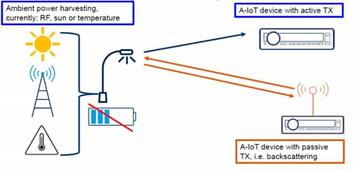
Ambient Backscatter Communication: Principles and Applications
Explore ambient backscatter communication, a technology enabling devices without dedicated power sources or transmitters to communicate by reflecting ambient RF signals.
Showing 25 posts (Page 15 of 139)
Advertisement

Explore ambient backscatter communication, a technology enabling devices without dedicated power sources or transmitters to communicate by reflecting ambient RF signals.

Discover Ambient IoT (A-IoT): its features, benefits and limitations for pervasive connectivity.
Compare Ambient IoT Vs traditional IoT and explore difference between ambient IoT (A-IoT) and classic IoT.

Understand the core differences between ammeters, voltmeters, and multimeters, their uses, and how they connect to circuits. Includes link to analog vs digital multimeters.

Explore 5 key advantages and disadvantages of AMOLED display screens including its benefits like vibrant colors, energy efficiency and drawbacks like potential screen burn-in and higher production costs.

Compare AMOLED vs IPS LCD display and explore difference between AMOLED and IPS LCD technologies, including their structures, advantages and disadvantages.

Compare AMOLED vs OLED and explore difference between AMOLED and OLED display technologies, including their structures, advantages and disadvantages.

Explains the fundamental difference between amplification (power gain) and attenuation (power loss) in RF engineering, with formulas and illustrations.
This article compares amplifier classes A, B, AB, and C, highlighting their key characteristics and performance metrics.

Explains amplitude and phase balance in RF power dividers, highlighting their definitions, measurement, and importance in RF design.
Explore the key differences between AMPS, TACS, and NMT, three analog cellular telephone standards, including their frequency bands, duplex schemes, and multiple access methods.

Understand the AMQP architecture: publishers, subscribers, broker roles, exchanges, queues, and frame types for asynchronous messaging.

Explore the advantages and disadvantages of the AMQP protocol, commonly used in IoT applications. Learn about its architecture, benefits, and drawbacks.
Explore a detailed comparison of AMQP and JMS protocols, highlighting their features, message formats, models, and key differences for messaging systems.

Explore the fundamentals of Adaptive Multi-Rate (AMR) technology in GSM, including codec modes, operation, and channel coding for optimized voice quality.
Explore AMR conformance testing, loopback procedures, and key specifications for GSM devices. Understand tests for speech channels, bad frames, sensitivity, and more.

Explore the core differences between Automated Manual Transmission (AMT) and Continuously Variable Transmission (CVT) in this comparison. Understand their mechanisms, advantages, and disadvantages.

Explore analog beamforming basics, including its working principle, benefits like simple implementation and low power, and drawbacks such as limited data rate.

Explore 5 key advantages and disadvantages of analog CCTV systems, comparing them to IP CCTV systems. Understand their capabilities, benefits and limitations.

Explore the core differences between Analog and IP CCTV systems, including resolution, cabling, scalability, features, and cost.

Understand the key differences between analog and digital comparators, including their definitions, functionality, and applications.
Explore the distinctions between analog and digital delay, focusing on signal processing, musical applications, and achievable delay times.

Explore Analog Front Ends (AFEs), their critical functions in signal processing, and popular integrated circuits (ICs) used across various industries.

This article compares analog and digital multipliers, explaining their definitions, working principles, and key differences with illustrative figures.

Explore the key differences between analog and digital switches, focusing on their definitions, working principles, specifications, and applications.
Advertisement